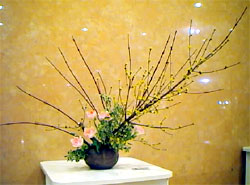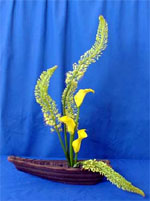|
|
|
|
Top Japan Destinations:
Tokyo hotels Osaka hotels Kyoto hotels Nagoya hotels Sapporo hotels See more hotels in Japan
World Destinations:
 Guides » Japan » The Art of Ikebana Guides » Japan » The Art of IkebanaThe Art of Ikebana
Ikebana is a traditional art form of Japan that has been practiced for the past 600 years. The development of Ikebana came as a ritualistic offering from the Buddhist to the spirits of the dead in the form of flowers. Around the mid-15th century as more, classical styles emerged Ikebana became independent from its religious connections although even to today, it remains symbolic.
The first people to teach this type of flower arrangement art were actually priests along with various members of nobility. Eventually, schools were established whereby Ikebana was taught to all levels of society. The beginning of Ikebana dates back to the 6th century. The flowers would be laid on the altar as part of worship and in honor of Buddha. In the country of India, where Buddhism originated, flowers were informally placed while other times, petals would be tossed about.  Then in the 10th century, the offerings given by the Japanese people were placed in containers, where the priests would take them to the temple, again in honor of Buddha. One priest from the beginning from the Rokkakudo Temple in the city of Kyoto was so remarkably skilled that his teachings were sought after by other priests. The word, Ikebana, came from the fact that this particular priest lived by a lake called by the Japanese, “Ikenobo”. With that, the name was changed slightly to what we know as today being the art form of Ikebana. Then in the 10th century, the offerings given by the Japanese people were placed in containers, where the priests would take them to the temple, again in honor of Buddha. One priest from the beginning from the Rokkakudo Temple in the city of Kyoto was so remarkably skilled that his teachings were sought after by other priests. The word, Ikebana, came from the fact that this particular priest lived by a lake called by the Japanese, “Ikenobo”. With that, the name was changed slightly to what we know as today being the art form of Ikebana.
Interestingly, while the offering of the flowers is the same, you will find the styles of Ikebana have evolved over the years.  Then as time passed, Ikebana exhibitions became commonplace among the Japanese festivals and today people enjoy making Ikebana for the pure pleasure of doing so. Early styles of Ikebana included a tall, upright central stem that would be accompanied by shorter stems. While beautiful, this specific style represented heaven, man, and earth. Then as time passed, Ikebana exhibitions became commonplace among the Japanese festivals and today people enjoy making Ikebana for the pure pleasure of doing so. Early styles of Ikebana included a tall, upright central stem that would be accompanied by shorter stems. While beautiful, this specific style represented heaven, man, and earth.
In 1545, the Ikenobo School created new principles of Rikka arrangements, which involved naming the seven principal branches that were used in the arrangement. With such great interest in Ikebana, more and more schools were established, each with a unique interpretation, which is where we get so many wonderful styles. For instance, the Enshu School exaggerated curves of the branches by cutting slits in them or bending them. However, the Koryu School preferred to place the Komi at an angle whereby the ends of the stems were cut at an angle and then propped against the container or vase. However, at the turn of the 20th century, a revolution of Ikebana styles emerged. At this time, Ikebana was very popular, something often performed by many Japanese women. A professor at Kobe University by the name of Unshin Chara designed a new form of Ikebana that used a low bowl and some of the shorter stemmed western flowers. Although he asked the school to teach this new style called Moribana, they refused so he headed off to start his own school called the Ohara School. Following his style of Moribana, which translates to “piled up”, Ikebana schools sprouted all over the country, as people grew more interested in learning this and other styles. In fact, the Saga School, which is located in the Daikakuji Temple, is still in operation today. Soon, more styles were created, one called the Adachi Style whereby flowers were arranged like flowers but it would be the Literati Style that would captures everyone’s attention with its innovative and colorful approach. Today, this Japanese art form of flower arrangement remains magnificent. While most arrangements are simple, they take practice and an understanding of the principals to achieve. Remember, Ikebana is a creative expression that falls within specific rules of construction. Learning to work with the materials that consist of branches, leaves, blossoms, and grasses is at the heart of Ikebana. The result is a magical arrangement that is the perfect balance of graceful lines and natural shapes. If you appreciate the culture and history of Japan and love beautiful but unique flower arrangements, then you might consider finding an Ikebana school in your area so you too can learn this spectacular and time-honored art. Ikebana is like painting a masterpiece, something that you can complete and then sit back to admire. This type of art form is a part of Japan’s recorded history that is supported by the country’s articulate theories. Simply stunning, Ikebana is like no other flower arrangement in the world. Last Updated: 10/19/2006 3:14:00 PM Mode articles for Japan If you are planning a trip to Japan, the first thing you need to do is put any of your preconceptions aside. In other words, because Japan is such a diverse country, it is many things to different people.
As an
If you are planning a trip to Japan, the first thing you need to do is put any of your preconceptions aside. In other words, because Japan is such a diverse country, it is many things to different people.
As an ... continue >>  When visiting the country of Japan, plan adequate time and wear comfortable clothing and shoes so you can enjoy the incredible sightseeing opportunities. In Japan, many of the places people go to see and experience are
When visiting the country of Japan, plan adequate time and wear comfortable clothing and shoes so you can enjoy the incredible sightseeing opportunities. In Japan, many of the places people go to see and experience are ... continue >>  The highest mountain in all of Japan is called Mt. Fuji, reaching skyward to 12,385 feet. This mountain is the only natural feature typically explored by tourists, simply because it is so magnificent. This perfectly
The highest mountain in all of Japan is called Mt. Fuji, reaching skyward to 12,385 feet. This mountain is the only natural feature typically explored by tourists, simply because it is so magnificent. This perfectly ... continue >> |
|
| | |
|
©2025 HotelsRu.com About us Privacy Site map Japan: The Magical Land |
|
 Look for deals on hotels?
Look for deals on hotels?